Suzanne Stengl's Blog, page 16
May 27, 2014
James Scott Bell
 Last Saturday, the Calgary Association of the RWA (CARWA) held its annual Spring Craft Workshop. Our featured speaker was James Scott Bell. More than fifty writers attended from Calgary and beyond.
Last Saturday, the Calgary Association of the RWA (CARWA) held its annual Spring Craft Workshop. Our featured speaker was James Scott Bell. More than fifty writers attended from Calgary and beyond.
Jim is the author of thrillers such as: Final Witness, Don’t Leave Me, and One More Lie. Writing as K. Bennett, he is the author of the Zombie Legal Thrillers: Pay Me in Flesh, Eating Dangerously, and I Ate the Sheriff.
He has also written several books on the craft of writing including Plot & Structure, Conflict & Suspense, The Art of War for Writers, and his latest, Write Your Novel From the Middle.
On the Friday evening before the workshop, the Board took Mr. Bell up the Calgary Tower to the “Sky 360” revolving restaurant. Since I am CARWA’s Membership Chair, the Board invited me to dinner as well. (Yay!)
The sun does not set until about 9:30 and the evening was clear, so we had an excellent view of the city and the Rocky Mountains. Here are some of the board members on the observation deck of the Calgary Tower.
And here is the whole board with JSB in the “Sky 360” restaurant.
 Back: James Scott Bell, Alyssa Linn Palmer, Roxy Boroughs, Shelley Kassian
Back: James Scott Bell, Alyssa Linn Palmer, Roxy Boroughs, Shelley Kassian
Front: Moira Stelmack, A.M. Westerling, Brenda Sinclair
Jim is from Los Angeles and has lived there all his life. He was interested in trying something Canadian, so he ordered the elk. I mean, how often do you get to eat elk? He also asked the waitress to suggest a wine that was “conversational without being verbose” and she brought this. 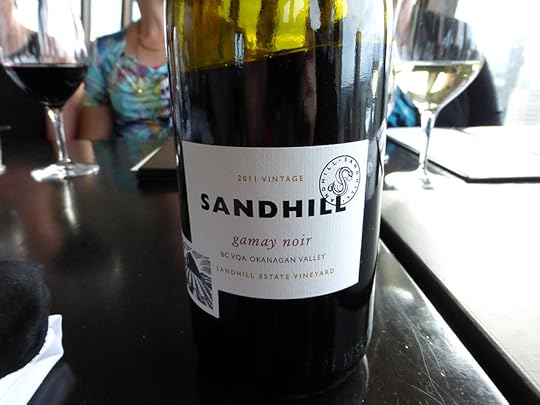 A Canadian wine from the South Okanagan, near Oliver, British Columbia. Apparently, it pairs well with the elk!
A Canadian wine from the South Okanagan, near Oliver, British Columbia. Apparently, it pairs well with the elk!
On Saturday, Jim presented his workshop called WRITING THE KNOCKOUT NOVEL. Some of the topics he covered were:
What Plot is really all about
Creating characters that “jump off the page”
The fastest way to improve your manuscript
The essentials of great dialogue
And he gave us the best interpretation of Casablanca I have ever heard. He also talked about his new craft book, Write Your Novel From the Middle. Click on the image at the beginning of this post and it will take you to Amazon where you can make the best “under $3 craft book” purchase of your life. Seriously.
After the workshop, we debriefed at the Toad ‘n’ Turtle. Jim chose the Big Rock Grasshopper Ale.

And, ever adventurous, he also tried that Canadian delicacy, poutine.  Poutine is originally from Quebec, made with french fries, topped with a light brown gravy and cheese curds.
Poutine is originally from Quebec, made with french fries, topped with a light brown gravy and cheese curds.  He asked if it came with a cardiologist.
He asked if it came with a cardiologist.

James Scott Bell with Suzanne Stengl
You can find Jim on his website and, on Sundays, at The Kill Zone—where he blogs about writing and writing related topics.
Have you been to a James Scott Bell workshop? Have you read one of his craft books? What’s the most important thing you’ve learned from JSB?
The post James Scott Bell appeared first on Suzanne Stengl.
May 20, 2014
Victoria Day
Queen Victoria was the first sovereign of Confederated Canada. After her death in 1901, May 24th, her birthday, became known as Victoria Day. Not only is this a celebration of Queen Victoria’s birthday, it is also the officially recognized celebration of the current reigning Canadian sovereign’s birthday.
To most Canadians, Victoria Day means summer is finally here.
Or it’s supposed to be . . .
Nowadays, Victoria Day does not always fall on May 24th but rather on the Monday that occurs before May 25th. That could be May 24th but it could also be as early as May 18th. This year it was May 19th, and Mother Nature was simply not ready.
It’s been this kind of weekend:
Cloudy with 60 percent chance of showers this evening then partly cloudy. Risk of a thunderstorm this evening. Fog patches developing after midnight. Wind north 20 km/h gusting to 40 becoming light this evening. Low plus 5.
Obviously, not a good weekend for planting a garden, but I did prune the Nanking Cherry. And I brought some bare branches inside and put them in water.  A couple of days later, the blooms popped. Nothing blooming outside yet, but my kitchen looks pretty.
A couple of days later, the blooms popped. Nothing blooming outside yet, but my kitchen looks pretty.
Is it warm where you are?
The post Victoria Day appeared first on Suzanne Stengl.
May 13, 2014
First Planting
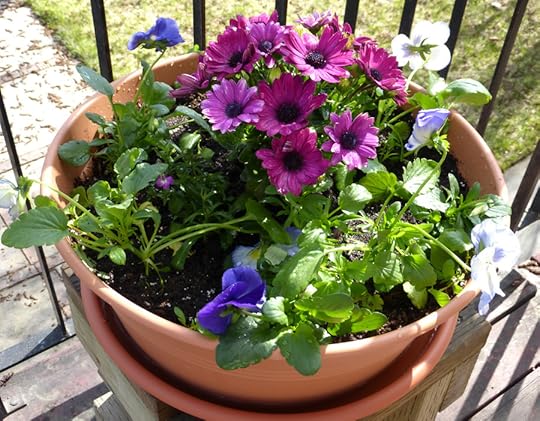 In Calgary, no one plants gardens until at least May 24th, or after the Victoria Day weekend.
In Calgary, no one plants gardens until at least May 24th, or after the Victoria Day weekend.
The daytime weather is fine and it might seem like the little plants could survive. Yesterday, it was 15 degrees Celsius (59 Fahrenheit) but last night that dropped to 3 degrees (37 Fahrenheit) and there’s a high probability that we’ll get frost again before summer arrives. Of course, you can plant a container garden anytime you want.
This time I used a shallow plastic pot because, until the risk of frost has passed, I’ll be moving my container garden back and forth from the balcony to the kitchen. The smaller pot means I’ll have to water it more often, but that’s okay.
I know a lot of gardeners wear gloves while planting but I like to get my fingers in the dirt. If you do too, it’s a good idea to scratch your fingernails over a bar of soap before you do your planting. It makes it easier to clean up afterwards.
My first container of the season consists of pansies, trailing lobelia, and Osteospermum—sometimes called Blue-eyed Daisy or African Daisy.
Do you get a jump on spring planting with container gardening? What are your favourite flowers to start off the season?
The post First Planting appeared first on Suzanne Stengl.
May 6, 2014
Prairie Crocus
 Every spring, the Prairie Crocus is the first plant to bloom on the prairie—even when it’s still snowing, like it has been in Calgary.
Every spring, the Prairie Crocus is the first plant to bloom on the prairie—even when it’s still snowing, like it has been in Calgary.
The Prairie Crocus has many names. I’ve been looking through my four plant identification books and, while they all refer to the Prairie Crocus, they don’t seem to agree on a botanical name. Some say Pulsatilla patens. Some say Anemone patens.
The Prairie Crocus is also called Cutleaf Anemone, Prairie Anemone, and Pasque-flower. But in Calgary, we call it the Prairie Crocus.
The flowers are usually pale blue or mauve but sometimes they are white or light yellow. When they open they are 1 ½ inches to 2 ½ inches in diameter.
 Generally, flowers have Sepals and Petals. A sepal is the outer part of the flower. And the petals are within the sepals. Sepals are usually green and their job is to protect the tender petals inside.
Generally, flowers have Sepals and Petals. A sepal is the outer part of the flower. And the petals are within the sepals. Sepals are usually green and their job is to protect the tender petals inside.
In the case of the Prairie Crocus, there are no petals, only sepals, 5 to 7 sepals. These sepals, of course, are not green. They are the showy colours we see on the brown prairie hillsides.
Each stem holds one bloom. The stems are about 4 inches high and they are “hairy” or “woolly” as though Mother Nature decided to dress them warmly so they can tolerate the cold spring.
 In fact, the Prairie Crocus knows a lot about staying warm. The sepals create a saucer shape, allowing the crocus to direct the sunlight on the inner stamens and pistils. Not only that, this intelligent plant follows the sun as it crosses the sky, collecting warmth all day long. The warmth helps the pollen and seeds develop, and provides a warm place for insects on a chilly spring day.
In fact, the Prairie Crocus knows a lot about staying warm. The sepals create a saucer shape, allowing the crocus to direct the sunlight on the inner stamens and pistils. Not only that, this intelligent plant follows the sun as it crosses the sky, collecting warmth all day long. The warmth helps the pollen and seeds develop, and provides a warm place for insects on a chilly spring day.
The Prairie Crocus is found in the dry prairie grasslands throughout the Prairie Provinces of Manitoba, Saskatchewan and Alberta. Manitoba has adopted the flower as its floral emblem, and it appears on this stamp with Manitoba’s coat of arms.
 Do you have Prairie Crocuses where you live? Is that what you call them? Or do you give them a different name?
Do you have Prairie Crocuses where you live? Is that what you call them? Or do you give them a different name?
Crocuses from Rolf Stengl
Stamp from Canstockphoto.com #6572872
The post Prairie Crocus appeared first on Suzanne Stengl.
April 29, 2014
Changing Seasons
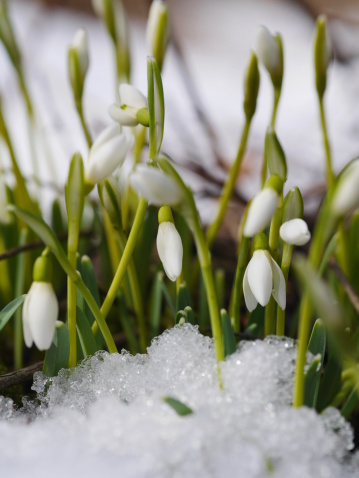
snowdrop flowers
Spring is arriving in fits and starts. It snowed last week but we’re raking leftover leaves, preparing for the grass to turn green. A few brave tulips are poking their heads out of the ground.
Meanwhile, on the other side of the world, my globetrotting sister has finished another scuba diving holiday. This time she was at the Farasan Islands in the Red Sea. Here she is reading ON THE WAY TO A WEDDING.
 Is it spring where you are?
Is it spring where you are?
snowdrop flowers from thinkstockphotos.com #465210053
The post Changing Seasons appeared first on Suzanne Stengl.
April 22, 2014
Taking pictures, keeping memories
 This is a Panasonic LUMIX ZS25 Compact Long Zoom. It takes 16 MP pictures, has full HD video and has 20 times zoom. All that and it neatly fits in my pocket. Settings include Intelligent Auto and manual exposure and scene modes for everything from portraits to sports to starry sky. And there’s a self timer.
This is a Panasonic LUMIX ZS25 Compact Long Zoom. It takes 16 MP pictures, has full HD video and has 20 times zoom. All that and it neatly fits in my pocket. Settings include Intelligent Auto and manual exposure and scene modes for everything from portraits to sports to starry sky. And there’s a self timer.


I’m still familiarizing myself with what this camera can do. But, while I know it can capture memories, I know it can’t keep them for me.
Long ago, my Uncle Lawrence had a Kodak Brownie and a passion for taking pictures. Not only did he capture the moment, he had the film printed and he wrote in pencil on the back of the picture. Sometimes it was only the date. Sometimes it was more.
“1937, taken from the Thames River near the lighthouse”
Nowadays we don’t need to worry about dating a picture, except to make sure the camera’s date and time are set correctly. But we do need to record more than the picture. Ironically, there are so many pictures taken, that the story behind those pictures can be buried. There is a saying in the scrapbooking world: Mama, don’t let your babies grow up to be jpegs.
Of course there is photo software to organize and write about your pictures. But as long as the pictures are digital, it can all be lost in a shuffle of electrons. The rule of thumb is that the photo does not exist unless it is in three places: your computer, an external hard drive and the cloud.
But we need to do more than that. We need to print a few. Just a few. And put them in an album of some kind and give them some words. Yes, a picture is worth a thousand words, but give the picture at least some little caption.
We are trying to figure out who is in this picture. We have an idea of the town.  But wouldn’t it be wonderful if someone had thought to scribble a date on the back?
But wouldn’t it be wonderful if someone had thought to scribble a date on the back?
My mother framed a lot of pictures. Her walls were lined with framed pictures. She wrote notes on the back of each frame. Without the words, you are left with a pretty frame and an interesting picture, but no idea of your connection to the people in that picture.
How about you? Do you take a lot of pictures? Do you have a system for recording the events and the people in your pictures? Are your memories buried in jpegs?
photo of camera from panasonic.com
The post Taking pictures, keeping memories appeared first on Suzanne Stengl.
April 15, 2014
The Easter Bunny
The long winter is over and this Sunday, April 20th, is finally Easter Sunday. Last Friday, I saw my first robin so I’m convinced spring has arrived. Now it’s time to start looking for the Easter Bunny.
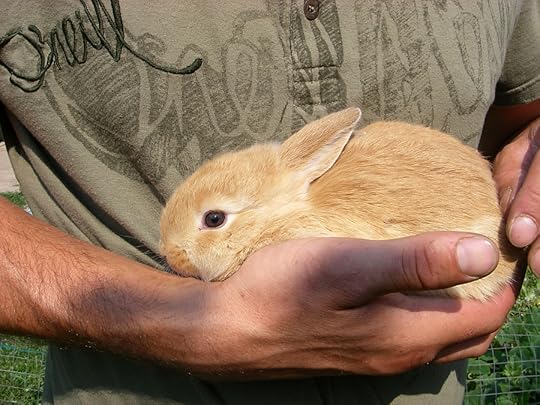 Here is a baby Easter Bunny.
Here is a baby Easter Bunny.
The Easter Bunny is a special kind of rabbit that lays eggs. Actually, they only lay Easter Eggs, not the kind with yolks. And they started doing this in the 18th century in the USA.
Apparently, German immigrants brought the tradition to America. To make things more confusing, these German immigrants where known as the Pennsylvania Dutch. They were really the Pennsylvania Deutsch, and Deutsch means German. But that’s another story.
At any rate, for this tradition, the Osterhase brought coloured eggs to the good little boys and girls. However, hase means hare, not rabbit. So the Northern Europeans had an Easter Hare rather than an Easter Rabbit.
The two animals look somewhat alike, but they are different species, and they cannot breed.
Hares are usually larger than rabbits and have longer ears.
Hares live above ground in nests. Their young are born fully furred and with their eyes open so they can take care of themselves soon after they are born.
Rabbits dig underground tunnels, and live in these burrows or warrens. Their young are born blind, hairless, and helpless.
Hares have 48 chromosomes. Rabbits have 44 chromosomes.
Rabbits are kept as pets, but hares have not been domesticated. And, in North America at least, Hares do not lay Easter Eggs.
I hope the Easter Bunny brings you lots of chocolate this Sunday.
The post The Easter Bunny appeared first on Suzanne Stengl.
April 8, 2014
Easter
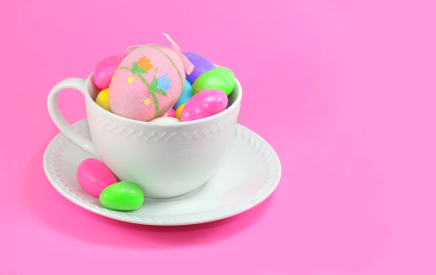 This Sunday, April 13, 2014 is Easter Sunday. Last year, Easter was on March 31, 2013. The year before that, it was April 8, 2012. So what gives?
This Sunday, April 13, 2014 is Easter Sunday. Last year, Easter was on March 31, 2013. The year before that, it was April 8, 2012. So what gives?
Correction: In 2014, Easter Sunday falls on April 20th, not the 13th. In my excitement to meet the Easter Bunny, I accidentally moved Easter a week ahead! This is an example of how confusing it is to have the date change every year.

The date of Easter (a Christian celebration) changes each year, according to the phases of the moon.
Well, not quite.
The date of Easter varies from March 22 to April 25. In the beginning, the Christian church fathers wanted to observe Easter right after the Jewish Passover. Passover is based on lunar cycles. Basically, Easter Sunday falls on the first Sunday following the first full moon following the northern Spring Equinox. If the full moon occurs on the Equinox, the calculation is taken from there.
However, the celebration is not really dependent on the lunar calendar but rather on tables that were created a long time ago, in 325 AD, in a place called Nicaea. Using the tables, the full moon is considered the 14th day of a lunar month and that may differ from the actual full moon by a day or even two days. Since the full moon can occur on different dates depending on where you stand on the planet, the use of the tables was necessary. These tables were not astronomically exact, but they were close. For one thing, the equinox was considered to be on March 21, although astronomically the equinox falls on March 20 in most years.
In 1583, the tables were modified slightly, but the tables are still used to determine the date of Easter.
The Earliest Ever Easter was Sunday March 22, 1818.
That will happen again in 2285.
The Latest Easter was Sunday April 25, 1943.
That will happen again in 2038.
Over the years, suggestions have been made for changing the date of Easter. It has been proposed that the Easter calculation be based strictly on direct astronomical observation. Another proposal was made in Britain to fix the date as the first Sunday after the second Saturday in April. However, nothing has changed yet.
In Calgary, Alberta, Canada, we have had snow and zero Celsius temperatures until the end of last week. In fact, it seems that March came in like a lion and left the same way. So we were not ready for a Spring Celebration in March. Having Easter show up on April 13th is more appropriate for us.
What about Easter Eggs?
No one knows the origin of decorating eggs for Easter, but I’m sure you grew up with one or both of these customs.
Hard boiling eggs in water coloured with food colouring.
Poking a hole in either end of the shell, blowing out the contents (to be used later for scrambled eggs) and then decorating the shell with felt markers or gluing on bits of fabric.
Perhaps you suspended your pretty egg shells from a branch of pussy willow, another harbinger of spring.
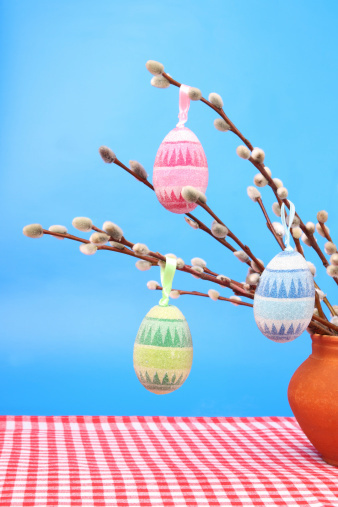
You might like to know that the world’s largest Easter Egg is located in my home province of Alberta, in the town of Vegreville. It is 31 feet long and weighs 5,512 pounds. Unfortunately, it is not made of chocolate.

Vegreville Pysanka from Wikipedia
You can read about Vegreville’s giant Easter egg, or Pysanka, here. Ukrainian Easter eggs are known as pysanky and the tradition of decorating them dates to the pre-Christian era.
This Sunday, how are you welcoming Spring and Easter? Will you have coloured hard boiled eggs? What colour? Or will you have scrambled eggs for breakfast while admiring your Easter Egg tree? Or will you settle for the newer tradition of chocolate eggs? Will you hide any?
Easter Eggs in a cup from iStockphoto.com #000008542559
pussy willows and Easter eggs from thinkstockphotos.com #179299286
Vegreville Pysanka from Wikipedia
The post Easter appeared first on Suzanne Stengl.
September 22, 2013
99 cents SALE!
It’s Sweet Romance / Coming Of Age
http://amzn.to/11FxaSB
An isolated forest road, a car in the ditch, a sprained ankle, a wedding dress...
ANGEL WINGS is free for the next 5 days!
It’s Sweet Romance / Light Paranormal
She’s his first assignment. He’s her first Angel!
http://amzn.to/X67YrM



